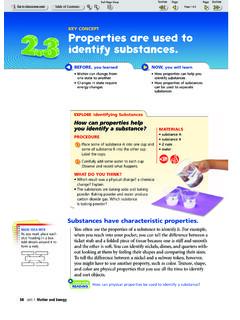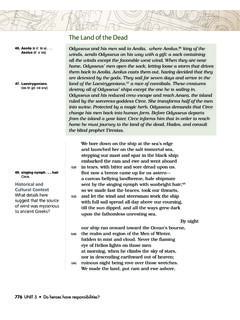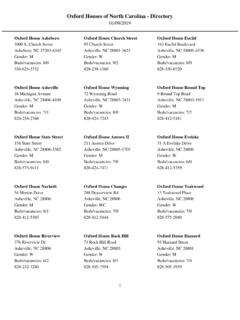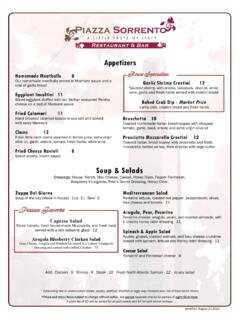Transcription of BVP1-5 Broadcast Scripts
1 Broadcast SCRIPTSACCT- BVP1-5 . Students will identify and create different script types. a. Identify Scripts by format. b. List steps leading to the development of various type ( , news and/or sitcom) Broadcast Scripts . c. Define terminology used in Broadcast scriptwriting. d. Plan and produce a storyboard. e. Write Broadcast Scripts as assigned. IntroductionToo many students experience anxiety when they hear the word writing. One of the best things that can be said about television scriptwriting is that it bears little resemblance to the writing style required for academic courses.
2 Although scriptwriting is relatively simple to do, good scriptwriting takes talent and skillProgram FormatsA script is an entire program committed to paper. It includes dialog, music, camera angles, stage direction, camera direction, computer graphics (CG) notations, and all other items that the director or script writer feels should be are many different kinds of television programs, each with unique requirements of the script. Most programs fit into one of the following categories: Lecture. The lecture program format is the easiest format to shoot; the talent speaks and the camera shoots almost entirely in a medium close-up.
3 All that is needed for this format is the talent, a camera, and a podium for the talent to stand behind. Other names for the lecture format are BTF (big talking face) or talking head. This format has the lowest viewer retention and is often the mark of an amateur. Lecture/Demonstration. The lecture/demonstration format lends itself to the numerous cooking shows, how-to shows, and infomercials seen on television today. This format is more interesting to watch than a lecture alone because of the action and many props used by the Formats Panel Discussion.
4 The many Sunday morning network programs that bring a group of professionals together to discuss current news and political topics are examples of the panel discussion format. Also included are the popular daytime talk shows. These programs are not difficult to produce, as long as there is a limited number of people on the panel. Panel discussions are driven by the program s content, not action. As more people are added to a panel discussion, the shot to include all members gets rather wide. A wide shot is also a tall shot. This increases the risk of shooting off the top of the set.
5 To keep the top of the set in the shot, the camera may need to tilt down and inadvertently make the studio floor the most prominent item in the picture. location or in the studio, the two-person interview can be elcetifying. Peopl like Barbara Walters have build entire careers on making a simple conversation a complelling program for the audience. The interview format is often shot with only one camera. To get various camera angle cuts between the interviewer and the interviewee, the interviewee is shot for the entire duration of the interview.
6 The audio picks up the questions asked by the interviewer , but the camera only shoots the interviewees' face. After interviewee has left the set, the camera shoots the interviewer asking same questions a second time and records some nod shots. Program FormatsNod shots are a special kind of cutaway The interviewer does not sty anything, but simply nods naturally as if listening to the answer to a question. When collecting nody shots, the interviewer faces the direction where the interviewee was positioned during the interview.
7 In the editing room, the angles and not shots are cut together to create what looks like a conversation between the two people. documentary program is essentially a research paper for television; the topic is researched, the information is outlined, and the script is written. The audio in a documentary may be either off-camera narration, or on-camera narration, or a combination of both. The audio portion f the script should be roughly written out before any shooting begins. In the process of writing, a shot sheet is develop. For a documentary program a shot sheet is like a grocery list of shots needed to support the audio portion of the script.
8 When shooting, the shots on the list are Additionally , the director watches for other shots that include specific items, people, or anything that adds to the program's content and would be interesting to the viewers. Shot sheets are only a guide and are rarely long enough to provide enough footage to assemble an entire program. Always shoot more footage than is listed on the shot Formats term includes both dramas and comedies. The drama format requires a different kind of talent, actors. Actors take on a role in a program and perform as someone or something other than themselves.
9 Magazine. The magazine format originated from programs like 60 minutes, but has become more than news-oriented programming. A regular news Broadcast presents each story in two minutes or less. A magazine format program is comprised of feature packages that address a single story. This allows more interesting detail to be included about each story, but fewer stories to be included in each program. Music Video. The music video has become a common and influential force in our culture. Items such as clothing shoes, fashion accessories, and hairstyles gain popularity when seen in a music video.
10 Music videos also serve to promote a band or a new song or album, in the hopes of increasing the sales of CDs and concert tickets. Most music videos are one of three types:Program Formats Concert Style. The audience sees the band perform the music that is heard. A concert style music video may include a compilation of different concerts the band has performed, a studio performance, or a various locations. Story Style. The audience hears the music, but never sees the band. Instead, actors act out a story line that is supported by the lyrics of the song.








